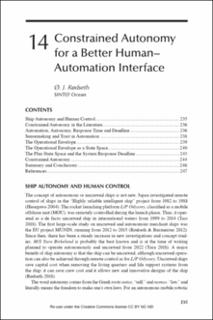| dc.contributor.author | Rødseth, Ørnulf Jan | |
| dc.date.accessioned | 2022-09-19T13:56:36Z | |
| dc.date.available | 2022-09-19T13:56:36Z | |
| dc.date.created | 2021-08-13T15:44:17Z | |
| dc.date.issued | 2021 | |
| dc.identifier.isbn | 978-0-367-42243-1 | |
| dc.identifier.uri | https://hdl.handle.net/11250/3018975 | |
| dc.description.abstract | The concept of autonomous or uncrewed ships is not new. Japan investigated remote control of ships in the “Highly reliable intelligent ship” project from 1982 to 1988 (Hasegawa 2004). The rocket launching platform L/P Odyssey, classified as a mobile offshore unit (MOU), was remotely controlled during the launch phase. Thus, it operated as a de facto uncrewed ship in international waters from 1999 to 2014 (Tass 2018). The first large-scale study on uncrewed and autonomous merchant ships was the EU project MUNIN, running from 2012 to 2015 (Rødseth & Burmeister 2012). Since then, there has been a steady increase in new investigations and concept studies. M/S Yara Birkeland is probably the best known and is at the time of writing planned to operate autonomously and uncrewed from 2022 (Yara 2018). A major benefit of ship autonomy is that the ship can be uncrewed, although uncrewed operation can also be achieved through remote control as for L/P Odyssey. Uncrewed ships save capital cost when removing the living quarters and life support systems from the ship; it can save crew cost and it allows new and innovative designs of the ship (Rødseth 2018). | en_US |
| dc.language.iso | eng | en_US |
| dc.publisher | Taylor & Francis Group | en_US |
| dc.relation.ispartof | Sensemaking in Safety Critical and Complex Situations: Human Factors and Design | |
| dc.relation.uri | https://www.taylorfrancis.com/chapters/oa-edit/10.1201/9781003003816-14/constrained-autonomy-better-human%E2%80%93automation-interface-r%C3%B8dseth?context=ubx&refId=10b9f360-badf-4a16-a020-918fd0a70a | |
| dc.rights | Navngivelse 4.0 Internasjonal | * |
| dc.rights.uri | http://creativecommons.org/licenses/by/4.0/deed.no | * |
| dc.title | Constrained Autonomy for a Better Human–Automation Interface | en_US |
| dc.type | Chapter | en_US |
| dc.type | Peer reviewed | en_US |
| dc.description.version | publishedVersion | en_US |
| dc.source.pagenumber | 13 | en_US |
| dc.identifier.doi | 10.1201/9781003003816 | |
| dc.identifier.cristin | 1925911 | |
| dc.relation.project | Norges forskningsråd: 267860 | en_US |
| dc.relation.project | EC/H2020/815012 | en_US |
| cristin.ispublished | true | |
| cristin.fulltext | original | |
| cristin.qualitycode | 1 | |

